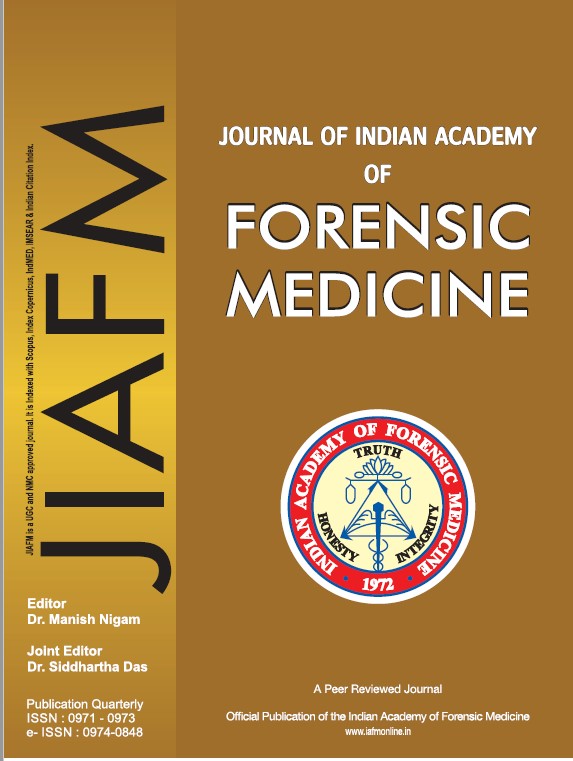Scientific Interpretation of Unusual Injuries Observed in a Death caused by Firing from an Unlicensed Rifled Firearm
DOI:
https://doi.org/10.48165/Keywords:
Forensic ballistics, Homicide, Unlicensed rifledfirearm, Secondary cavity, Pressure waves, Hydrostatic shockAbstract
Homicide is the act of killing one person by another. However, for convicting the accused various factors like motive, pre-planning, and circumstantial evidence are taken into consideration. There are various ways by which homicide can be accomplished. The method of using a firearm to kill a person is still less common in India as compared to western countries due to the stringent regulations to have a licensed firearm. However, people get unlicensed firearms (rifled or shotgun) from the black market. These are improvised firearms and lead to injuries which are not matching with the descriptions as per the prevailing conventional literature. This makes the interpretation of injuries by autopsy surgeons difficult to corroborate with circumstantial findings. Here we report a case where a middle-aged male is the victim of a gunshot by unknown individuals who had followed him knowing that he had withdrawn money from the bank. The gunshot is from an unlicensed rifled firearm which produced unusual injuries in multiple places. The authors had tried to deliberate the possible scientific explanation behind the causation of such an atypical pattern of injuries.
Downloads
References
NCRB (National Crime Records Bureau). New Delhi, India: NCRB, Ministry of Home Affairs, Government of India. 2009. Crime in India, 2008; [cited 2021 Apr 10]. Available from: http://ncrb.nic.in/cii2008/home.htm
NCRB (National Crime Records Bureau). New Delhi, India: NCRB, Ministry of Home Affairs, Government of India. 2018. Crime in India, 2018; [cited 2021 Apr 10]. Available from: http://ncrb.nic.in/cii2018/home.htm
Tank PW, rant JC. The Head, and Neck. In: Tank PW, Grant JC, editors. Grant's dissector. 13th ed. Baltimore, United States: Lippincott Williams & Wilkins; 2012.p. 174.
Ackley PO. Handbook for Shooters and Reloaders. 2nd
ed.United States: Echo Point Books and Media; 2015.
Kneubuehl BP. General wound ballistics. In: Kneubuehl BP, editor. Wound ballistics: basics and applications. Berlin: Springer; 2011.p. 87-162.
Sturtevant B. Shock wave effects in biomechanics. Indian
Acad Sci. 1998;23(5):579-96.
Roberts JC, Ward EE, Merkle AC, O'Conner JV. Assessing Behind Armor Blunt Trauma in accordance with the National Institute of Justice standard for personal body armor protection using finite element modeling. J Trauma. 2007;62(5):1127-1133.
Roberts JC, O'Conner JV, Ward EE. Modeling the Effect of Nonpenetrating Ballistic Impact as a Means of Detecting Behind-Armor Blunt Trauma. J Trauma. 2005;58(6):1241-
Suneson A, Hansson HA, Seeman T. Pressure Wave Injuries to the Nervous System Caused by High Energy Missile Extremity Impact: Part I. Local and Distant Effects on the Peripheral Nervous System. A Light and Electron Microscopic Study on Pigs. J Trauma. 1990;30(3):281-294.
Courtney M, Courtney A. Scientific evidence for hydrostatic shock [Internet]. Research Gate. 2008 [cited 2021 May 16]. Available from: https://www.researchgate.net
/publication/1916018_Scientific_Evidence_for_
Hydrostatic_Shock/references
Gresham G, Gresham T, Weatherby: the Man, the Gun, the Legend. 1st ed. Natchitoches, United States: Cane River Pub; 1992.
Fackler ML. Wound profiles. Wound Ballistic Rev.
;5(2):25-38.
Patrick UW, Handgun wounding factors and effectiveness, Firearms Training Unit. 1st ed. United States. FBI Academy; 1989.
Wang Q, Wang Z, Zhu P, Jiang J. Alterations of the Myelin Basic Protein and Ultrastructure in the Limbic System and the Early Stage of Trauma-Related Stress Disorder in Dogs. J Trauma. 2004;56(3):604-610.


